Title search results
Showing 1 - 20 of 4248 items
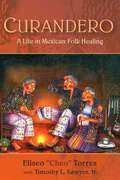
Curandero: A Life in Mexican Folk Healing
By Torres Eliseo “Cheo”, Timothy L. Sawyer. 2005
Eliseo Torres, known as Cheo, grew up in the Corpus Christi area of Texas and knew, firsthand, the Mexican folk…
healing practiced in his home and neighborhood. Later in life, he wanted to know more about the plants and rituals of curanderismo. Torres's story begins with his experiences in the Mexican town of Espinazo, the home of the great curandero El Niño Fidencio (1899-1939), where Torres underwent life-changing spiritual experiences. He introduces us to some of the major figures in the tradition, discusses some of the pitfalls of teaching curanderismo, and concludes with an account of a class he taught in which curanderos from Cuernavaca, Mexico, shared their knowledge with students.Part personal pilgrimage, part compendium of medical knowledge, this moving book reveals curanderismo as both a contemplative and a medical practice that can offer new approaches to ancient problems.From Curandero . . . for centuries, rattlesnakes were eaten to prevent any number of conditions and illnesses, including arthritis and rheumatism. In Mexico and in other Latin American countries, rattlesnake meat is actually sold in capsule form to treat impotence and even to treat cancer. Rattlesnake meat is also dried and ground and sprinkled into open wounds and body sores to heal them, and a rattlesnake ointment is made that is applied to aches and pains as well.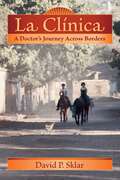
La Clínica: A Doctor's Journey Across Borders (Literature and Medicine Series)
By David P. Sklar. 2008
In 1972, when the world around him was making little sense, David Sklar left in his senior year of college…
to volunteer at a community clinic in rural Mexico. With absolutely no medical experience beyond being accepted to medical school at Stanford, Sklar literally learned medicine by practicing it. With duties that ranged from suturing wounds and delivering babies to digging latrines to pulling teeth, his time at the clinic took him into the heart of a medical world that the sterilized walls of the twentieth century would never have shown him. The experience challenged his idealism and, ultimately, molded him into a skilled emergency physician.Years later, deeply immersed in the stress of running the ER at the University of New Mexico Hospital and facing a divorce, Sklar decided to revisit the Mexican village and clinic that provided inspiration and grounding in the early stages of his career. Weaving together his time in Mexico, his later career, and his marriage, Sklar's memoir offers a thought-provoking meditation on the virtues of idealism in the face of the inevitable failures that haunt all human endeavors.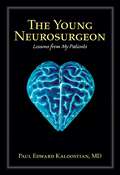
The Young Neurosurgeon: Lessons from My Patients (Literature and Medicine Series)
By Paul Edward Kaloostian. 2013
In the ER, the OR, and in the waiting room where the doctors deliver heart stopping news to the families…
of their patients, a neurosurgeon&’s apprenticeship is arduous. This memoir of the day-to-day experiences of a resident in neurosurgery at one of the nation&’s busiest trauma centers provides a rare window into the training of the doctors who open patients&’ skulls and operate on their brains and spinal cords. Paul Kaloostian&’s intimate account describes both the lifesaving feats and tragic failures that are the daily ups and downs of twenty-firstcentury neurosurgery. Kaloostian shares the lessons of humility, faith, and compassion that were often more important than the surgical expertise he acquired in the operating room.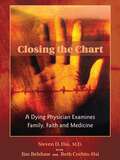
Closing the Chart: A Dying Physician Examines Family, Faith, and Medicine
By Steven D. Hsi. 2004
Dr. Steven D. Hsi, a family physician and father of two young sons, was diagnosed in 1995 with a rare…
coronary disease that caused his death five years later at the age of forty-four. Throughout his ordeals as a patient, including three open-heart surgeries, Dr. Hsi's outlook on the teaching and practice of medicine changed. In 1997 he began a journal intended for publication after his death. Written with the assistance of newspaper columnist Jim Belshaw and completed posthumously by Hsi's widow, Beth Corbin-Hsi, Dr. Hsi's writings urge his colleagues to become healers, to look at their patients as human beings with spiritual as well as physical lives.Every patient should read it, if only to be made aware that they are not alone with their thoughts. Every spouse of a patient should read it. . . . Every medical student and physician should read it to learn that the biology of the disease is really just a small part of the illness.--John Saiki, M.D., Medical Oncology, University of New MexicoDr. Steven Hsi asks his fellow doctors to be more than physicians. He asks them to be healers. He says that when he thinks of healers, he sees traditional medicine men, people who are integral parts of their communities. They are in touch physically and spiritually with the people they serve.--Tony HillermanClosing the Chart is built on the personal journals and experiences of Steven D. Hsi, M.D., as he travels on an intense 5-year journey from an assumption of health, professional success, and family stability to his progressive illness and eventual death. . . . Closing the Chart is both an engaging, page-turning read and a story told with so little artifice that you cannot close the cover unchanged.--Kenneth Jacobson, executive director, American Holistic Medical Association, Explore &“There are lessons on every page, lessons to make us better caregivers, more discerning patients, and better advocates for family members and friends who are sick. . . . Every reader will take away different lessons from this book based on his or her role, age, and experience. This would be an ideal book for group study by medical and nursing students with some senior physicians, patients, and family members. What a great learning experience for all participants! . . . I exhort you to pick up and read this humble story. Nothing I have encountered in the medical narrative genre has been more worthy of my time.&” —David J. Elpern, M.D, Psychiatric Services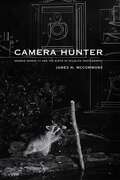
Camera Hunter: George Shiras III and the Birth of Wildlife Photography
By James H. McCommons. 2014
In 1906 George Shiras III (1859–1942) published a series of remarkable nighttime photographs in National Geographic. Taken with crude equipment,…
the black-and-white photographs featured leaping whitetail deer, a beaver gnawing on a tree, and a snowy owl perched along the shore of a lake in Michigan&’s Upper Peninsula. The pictures, stunning in detail and composition, celebrated American wildlife at a time when many species were going extinct because of habitat loss and unrestrained hunting. As a congressman and lawyer, Shiras joined forces with his friend Theodore Roosevelt and scientists in Washington, DC, who shaped the conservation movement during the Progressive Era. His legal and legislative efforts culminated with the passage of the Migratory Bird Treaty Act.Camera Hunter recounts Shiras&’s life and craft as he traveled to wild country in North America, refined his trail camera techniques, and advocated for the protection of wildlife. This biography serves as an important record of Shiras&’s accomplishments as a visual artist, wildlife conservationist, adventurer, and legislator.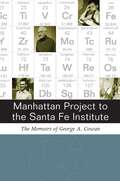
Manhattan Project to the Santa Fe Institute: The Memoirs of George A. Cowan
By George A. Cowan. 2010
The telephone lay in pieces on George Cowan's office desk in the basement of Princeton's physics building. It was his…
first day as a graduate student in the fall of 1941. Down the hall, on the door of the cyclotron control room, a sign warned, Don't let Dick Feynman in. He takes tools. On that day, the future Nobel Prize winner Richard Feynman needed a piece from his new office mate's phone, so he borrowed it without even introducing himself.Cowan's memoir is an engaging eyewitness account of how science works and how scientists, as human beings, work as well. In discussing his career in nuclear physics from the 1940s into the 1980s, Cowan weaves in intriguing anecdotes about a large cast of distinguished scientists--all related in his wry, self-deprecating manner.Besides his nearly forty-year career at Los Alamos National Laboratory, Cowan also helped establish banks in Los Alamos and Santa Fe, served as treasurer of the group that created the Santa Fe Opera, and in the late 1980s participated in founding the Santa Fe Institute and served as its first president. He anchored its interdisciplinary work in his quest to find common ground between the relatively simple world of natural science and the daily, messy world of human affairs.Since the early 1990s Cowan has pursued a new interest in psychology and neuroscience to gain a deeper understanding of patterns of human behavior.This autobiography will appeal to anyone interested in a concise, intellectually engaged account of science and its place in society and public policy over the past seventy years.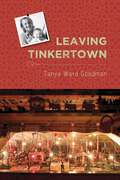
Leaving Tinkertown (Literature and Medicine Series)
By Tanya Ward Goodman. 2013
When Tanya Ward Goodman came home to New Mexico to visit her dad at the end of 1996, he was…
fifty-five years old and just beginning to show symptoms of the Alzheimer&’s disease that would kill him six years later. Early onset dementia is a shock and a challenge to every family, but the Wards were not an ordinary family. Ross Ward was an eccentric artist and collector whose unique museum, Tinkertown, brought visitors from all over the world to the Sandia Mountains outside Albuquerque. In this book Tanya tells Ross&’s story and her own, sharing the tragedy and the unexpected comedy of caring for this funny, stubborn man who remained a talented artist even as he changed before his family&’s eyes.
Rider of the Pale Horse: A Memoir of Los Alamos and Beyond
By McAllister Hull. 2005
A scientist's recollection of his life as a junior member of the Manhattan Project, Rider of the Pale Horse recounts…
McAllister Hull's involvement in various nuclear-related enterprises during and after World War II. Fresh from a summer job working with explosives in the chemistry department of an ordnance plant, Hull was drafted in 1943, after his freshman year in college. Unlike other accounts written by scientists and historians of that era, Hull's narrative offers a realistic picture of the dangerous and messy job that GIs and civilian powder men were asked to do. Life in the workshops where bomb components were constructed was very different from life in the offices where they were designed. Hull's description of his postwar work supporting the Bikini Atoll tests in the Pacific and the early concerns about the effects of a hydrogen bomb explosion illuminate the Dark Age of nuclear weaponry. John Hull's handsome illustrations show technicians and scientists at work and bring the story to life. Rider of the Pale Horse adds valuably to the total record of the most important technological development of the twentieth century.--Richard Rhodes, author of The Making of the Atom Bomb Hull gives a bottom-up view as seen by a foot-soldier. His account of the grubby details of the project is illuminated by his later view of its historical repercussions and bears new witness to a turning-point of history.--Freeman Dyson, author of Disturbing the Universe
Racing Uphill: Confronting a Life with Epilepsy
By Stacia Kalinoski. 2025
The candid, inspiring story of a woman&’s experience with a chronic, unpredictable neurological condition When twenty-nine-year-old reporter Stacia Kalinoski regained…
consciousness on a couch at the TV station where she worked, she assumed that she&’d had another seizure. But the electrical storm that had just torn through her brain was more destructive than she could have imagined, and the broadcast journalism career she loved swiftly came to an end. Forced to confront the reality of her medical condition, Kalinoski made the risky decision to undergo brain surgery, targeting the epilepsy that was ravaging her life. In Racing Uphill, Kalinoski describes the seizures that occurred while she was running, which led to her pursuit of an uncertain cure. Rallying the grit she developed as an athlete and engaging the research and reporting skills she acquired as a journalist, she gives us a rare inside look at the ways epilepsy can change a life. Moving beyond her own personal experience, Kalinoski interviews prominent epileptologists to understand how seizures can spread, steal memories, and create strange behaviors and mood disorders. She seamlessly joins what she learned from her research with her own story, offering valuable insight into the experience of grappling with a relentless neurological disease. The vivid auras that preceded seizures and the damage that followed; the toll of her epilepsy on her family and loved ones; the extraordinary determination her reckoning required—these are all part of Kalinoski&’s story of adversity, denial, acceptance, and resilience. In sharing the remarkable opportunity that epilepsy presented for her courage and growth, Stacia Kalinoski speaks to anyone facing an uphill battle and offers inspiration for taking control of one&’s own health.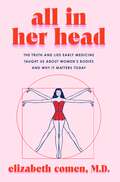
Finalist for the 2025 PEN/E.O. Wilson Literary Science Writing AwardUSA Today Bestseller“All in Her Head accomplishes a remarkable feat of storytelling.…
By combining essential medical histories about women’s bodies with all the narrative propulsion of a medical thriller, Comen has written a must-read, compelling, and important book.”—Siddhartha Mukherjee, Pulitzer Prize–winning author of The Emperor of All Maladies and The Song of the Cell“Wow! This book will upend everything you thought you knew about your body while empowering you to make better decisions moving forward. Through storytelling, extensive research, and easy recommendations, Dr. Elizabeth Comen has given us all a priceless road map to reclaim our agency.”—Eve Rodsky, author of Fair PlayA surprising, groundbreaking, and fiercely entertaining medical history that is both a collective narrative of women’s bodies and a call to action for a new conversation around women’s health.For as long as medicine has been a practice, women's bodies have been treated like objects to be practiced on: examined and ignored, idealized and sexualized, shamed, subjugated, mutilated, and dismissed. The history of women’s healthcare is a story in which women themselves have too often been voiceless—a narrative instead written from the perspective of men who styled themselves as authorities on the female of the species, yet uninformed by women’s own voices, thoughts, fears, pain and experiences. The result is a cultural and societal legacy that continues to shape the (mis)treatment and care of women.While the modern age has seen significant advancements in the medical field, the notion that female bodies are flawed inversions of the male ideal lingers on—as do the pervasive societal stigmas and lingering ignorance that shape women’s health and relationships with their own bodies.Memorial Sloan Kettering oncologist and medical historian Dr. Elizabeth Comen draws back the curtain on the collective medical history of women to reintroduce us to our whole bodies—how they work, the actual doctors and patients whose perspectives and experiences laid the foundation for today’s medical thought, and the many oversights that still remain unaddressed. With a physician’s knowledge and empathy, Dr. Comen follows the road map of the eleven organ systems to share unique and untold stories, drawing upon medical texts and journals, interviews with expert physicians, as well as her own experience treating thousands of women.Empowering women to better understand ourselves and advocate for care that prioritizes healthy and joyful lives— for us and generations to come—All in Her Head is written with humor, wisdom, and deep scientific and cultural insight. Eye-opening, sometimes enraging, yet always captivating, this shared memoir of women’s medical history is an essential contribution to a holistic understanding and much-needed reclaiming of women’s history and bodies.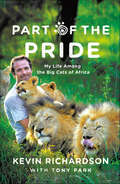
Part of the Pride: My Life Among the Big Cats of Africa
By Kevin Richardson, Tony Park. 2016
About a year ago, film started to circulate on YouTube® of a remarkable man named Kevin Richardson, an animal custodian…
in a South African animal park. The film showed Richardson in his day-to-day work, looking some of the world's most dangerous animals directly in the eye, crouching down at their level, playing with them and, sometimes, even kissing them on the nose--all without ever being attacked or injured. The films' popularity skyrocketed and Richardson became an international sensation. In "Part of the Pride", Kevin Richardson tells the story of his life and work, how he grew from a young boy who cared for so many animals that he was called "The Bird Man of Orange Grove" to an adolescent who ran wild and, finally, to a man who is able to cross the divide between humans and predators. As a self-taught animal behaviorist, Richardson has broken every safety rule known to humans when working with these wild animals. Flouting common misconceptions that breaking an animal's spirit with sticks and chains is the best way to subdue them, he uses love, understanding and trust to develop personal bonds with them. His unique method of getting to know their individual personalities, what makes each of them angry, happy, upset, or irritated—just like a mother understands a child—has caused them to accept him like one of their own into their fold. Like anyone else who truly loves animals, Richardson allows their own stories to share center stage as he tells readers about Napoleon and Tau, the two male lions he calls his "brothers"; the amazing Meg, a lioness Richardson taught to swim; the fierce Tsavo who savagely attacked him; and the heartbreaking little hyena called Homer who didn't live to see his first birthday. Richardson also chronicles his work on the feature film "The White Lion" and has a lot to say about the state of lion farming and hunting in South Africa today. In "Part of the Pride", Richardson, with novelist Tony Park, delves into the mind of the big cats and their world to show readers a different way of understanding the dangerous big cats of Africa.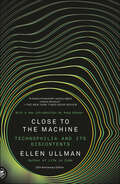
Close to the Machine: Technophilia and Its Discontents
By Ellen Ullman. 1997
With a New Introduction by Jaron Lanier A Salon Best Book of the Year In 1997, the computer was still…
a relatively new tool---a sleek and unforgiving machine that was beyond the grasp of most users. With intimate and unflinching detail, software engineer Ellen Ullman examines the strange ecstasy of being at the forefront of the predominantly male technological revolution, and the difficulty of translating the inherent messiness of human life into artful and efficient code. Close to the Machine is an elegant and revelatory mediation on the dawn of the digital era.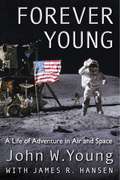
Forever Young: A Life of Adventure in Air and Space
By John W Young. 2012
He walked on the Moon. He flew six space missions in three different programs--more than any other human. He served…
with NASA for more than four decades. His peers called him the "astronaut's astronaut."Enthusiasts of space exploration have long waited for John Young to tell the story of his two Gemini flights, his two Apollo missions, the first-ever Space Shuttle flight, and the first Spacelab mission. Forever Young delivers all that and more: Young's personal journey from engineering graduate to fighter pilot, to test pilot, to astronaut, to high NASA official, to clear-headed predictor of the fate of Planet Earth.Young, with the assistance of internationally distinguished aerospace historian James Hansen, recounts the great episodes of his amazing flying career in fascinating detail and with wry humor. He portrays astronauts as ordinary human beings and NASA as an institution with the same ups and downs as other major bureaucracies. He frankly discusses the risks of space travel, including what went wrong with the Challenger and Columbia shuttles. Forever Young is one of the last memoirs produced by an early American astronaut. It is the first memoir written by a chief of the NASA astronaut corps. Young's experiences and candor make this book indispensable to everyone interested in the U.S. space program.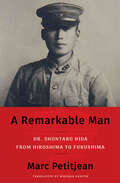
A Remarkable Man: Dr. Shuntaro Hida from Hiroshima to Fukushima
By Marc Petitjean. 2025
A poignant, eye-opening portrait of a witness to the atomic bomb who dedicated his life to treating and advocating for…
radiation survivors.As a young doctor, Shuntaro Hida (1917–2017) played an essential role in the aftermath of the Hiroshima bombing, which he witnessed firsthand only six kilometers from ground zero. Tending to the overwhelming number of victims, he would spend more than sixty years developing an unparalleled understanding of the harmful effects of radiation and warning against the reckless use of nuclear power.Through intimate, thoughtful interviews and compelling reportage, Marc Petitjean has created a worthy tribute to this determined, inspiring man who stood up to complicit governments and businesses. It testifies to the power of individuals to effect change as well as the importance of collective action, as demonstrated by organizations such as Nihon Hidankyo, a survivors&’ group that would receive the 2024 Nobel Peace Prize.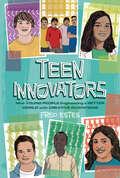
A water purification system made of concrete and the same chemicals that block ultraviolet light in sunscreen. A robot made…
of PVC pipe that beat a shiny, eleven-thousand-dollar competitor in a robotics contest. An electricity-producing windmill built by a teen who taught himself physics by candlelight. Teen Innovators: Nine Young People Engineering a Better World with Creative Inventions reveals how people of any age or experience level can create something that changes others' lives through nothing more than hard work, creativity, and inspiration. (Oh, and perhaps a bit of electrical wire, some plastic piping, and a couple tampons.) Utilizing the principles of design thinking, these inventors all tinkered, experimented, and failed—repeatedly—until their inventions worked. The windmill produced light. The water became safe to drink. Jack Andraka: improved pancreatic cancer test Gitanjali Rao: device to detect lead in drinking water William Kamkwamba: improvised electrical generator using windmill in Malawi Austen Veseliza: digital display glove to aid people with speech impairment Deepika Kurup: easier, cheaper method to remove toxins from drinking water Cristian Arcega, Lorenzo Santillan, Oscar Vasquez, Luis Aranda: underwater robot Each of these stories offers inspiration to the next generation of teen innovators. You don't need a genius-level IQ or the latest and greatest technologies to create something that makes a difference. All you need is an idea and the determination to make it real.
Ordures !: Journal d'un vidangeur
By Simon Paré-Poupart. 2024
L’univers du déchet s’est révélé à moi comme j’aimerais qu’il se révèle à vous dans ce livre. Par surprise. Un…
heureux hasard, car j’aime ce travail. En racontant mon histoire, je veux partager ma passion. Je veux sortir de l’oubli les vidangeurs. Je veux surtout que vous cessiez de croire que vos ordures disparaissent par magie, comme le propose la très récente pub de 1-800-GOT-JUNK. Rien ne disparaît par magie. Laissons ces illusions aux enfants et rentrons dans le vrai monde. Beau et sale, comme le sont les vidangeurs.» En lisant ce journal d’un vidangeur, vous ferez la découverte d’un monde dont vous ne soupçonniez pas l’existence. Un rassemblement d’excentriques et de personnages plus ou moins intégrés à la vie normale qui travaillent sur la ligne de crête entre ce que notre société considère propre et ce qu’elle juge sale. Qui sont ces athlètes qui courent nos rues chaque semaine derrière des camions, qu’il neige, qu’il pleuve ou qu’il fasse trop chaud? Quelle est leur vision du compostage, du recyclage, de la récupération? Qu’ont-ils à raconter sur une époque qui génère en abondance des ordures? Voilà autant de questions auxquelles répond ce récit captivant. Simon Paré-Poupart ramasse les ordures depuis vingt ans. Ses études universitaires en sociologie et en administration internationale, ainsi que son expérience comme intervenant social n’auront pas eu raison de sa vocation de vidangeur.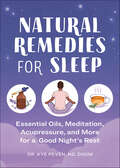
Discover non-pharmaceutical solutions for better sleepA good night's sleep can do wonders for your physical and mental health. But if…
you struggle with falling or staying asleep, your frustration may have you looking to sleep medicine for help. This natural remedies book will show you a better way. Natural Remedies for Sleep provides the knowledge, tools, and natural solutions for how to sleep smarter. Explore why we sleep, along with cognitive behavioral therapy (CBT) techniques, meditation, essential oils, acupressure, and more to help you get the full, consistent rest you deserve.Sleep 101—Learn the basics of what good sleep is, why we need it, some common sleep issues, and the short- and long-term benefits of a dependable night's sleep.Sleep tool kit—Good sleep takes planning—discover a list of the resources and items you need for getting a better night's sleep, and creating a smart sleep routine for yourself.Sleep scenarios—Find suggested natural sleep remedies for adults and techniques for overcoming a range of sleep problems and scenarios, such as insomnia, interrupted sleep patterns, and digestion issues.Fall asleep and stay asleep with the helpful and all-natural techniques and resources in this empathetic book.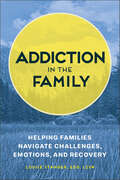
Addiction in the Family: Helping Families Navigate the Challenges, Emotions, and Recovery
By Louise Stanger. 2020
A practical and supportive guide for families struggling with addictionGet compassionate guidance that shows you how to navigate the unique…
challenges faced when a family member is suffering from a substance use disorder (SUD). Addiction in the Family helps you better understand what your loved one is going through while also offering realistic advice for approaching their addiction and how it affects your entire family.Drawing on Dr. Louise Stanger's years of experience as an SUD and family trauma clinician, Addiction in the Family allows you to take things at your own pace and concentrate on the areas where you need the most help. Whether it's finding ways to help your loved one, concentrating on your own self-care, or starting the healing and recovery journey, you'll find practical and thoughtful guidance.Addiction in the Family is:Family-focused—Get advice that addresses the dynamics and challenges of dealing with a partner, child, or other family member who is suffering from SUD.Practical and hopeful—Learn how to set boundaries, deal with strong emotions, and find addiction treatment options, as well as the best ways to communicate with a loved one compassionately and honestly.Filled with real-life examples—Realize that you aren't alone thanks to composite anecdotes—drawn from Dr. Louise's practice—that help you contextualize your experiences.Addiction in the Family will help you discover a measured and considerate way to approach a family member suffering from SUD.
The Easy Cannabis Cookbook: 60+ Medical Marijuana Recipes for Sweet and Savory Edibles
By Cheri Sicard. 2017
The definitive guide to making easy, everyday ediblesGo beyond just cookies and brownies as you learn how to serve up…
delicious edibles perfect for every meal with this comprehensive exploration of cooking with cannabis.Written by Cheri Sicard—nicknamed the "Martha Stewart of weed" by The Daily Beast—this cannabis cookbook provides you with absolutely everything you need to redefine stoner eats. Whether it's Ganja Gazpacho, Barbecue Chicken, or Deviled Eggs, these simple and straightforward recipes make it a breeze to bring unique, properly dosed edibles to the table.This must-have marijuana cookbook includes:Cannabis 101—Discover a crash course on the history of marijuana and all the benefits it provides.Dosing guides—Find out how to measure potency and make sure your infusions meet their mark.Cooking fundamentals—Learn fundamental cooking skills, what equipment you need, and more.60 Tasty recipes—Go beyond cookies and brownies with recipes for breakfasts, lunches, dinners, and more.Get baked, roasted, and grilled cannabis-infused treats for every meal thanks to The Easy Cannabis Cookbook.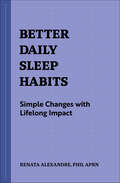
Better Daily Sleep Habits: Simple Changes with Lifelong Impact (Better Daily Habits)
By Renata Alexandre. 2021
Build long-term habits for a lifetime of better sleepStart sleeping better every night! Filled with straightforward and easy-to-implement advice, this…
book's expert guidance helps you build beneficial sleeping habits while putting an end to bad ones. You'll be waking up rested and ready to face the day in no time.Sleep smarter with:Simple adjustments—Learn how to create a sleep schedule, establish bedtime routines, eat wisely, and more in just a few steps.Relatable stories—Understand the effectiveness of these habit changes thanks to stories that demonstrate how they benefited actual sleep patients.Progress tracking—See how far you've come and keep yourself on the right track using the helpful habit trackers included with each chapter.Start sleeping better tonight with Better Daily Sleep Habits.